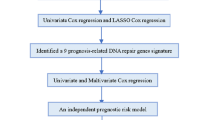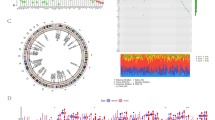Abstract
We hypothesized that a subset of sporadic triple negative (TN) breast cancer patients whose tumors have defective DNA repair similar to BRCA1-associated tumors are more likely to exhibit up-regulation of DNA repair-related genes, anthracycline-sensitivity, and taxane-resistance. We derived a defective DNA repair gene expression signature of 334 genes by applying a previously published BRCA1-associated expression pattern to three datasets of sporadic TN breast cancers. We confirmed a subset of 69 of the most differentially expressed genes by quantitative RT-PCR, using a low density custom array (LDA). Next, we tested the association of this DNA repair microarray signature expression with pathologic response in neoadjuvant anthracycline trials of FEC (n = 50) and AC (n = 16), or taxane-based TET chemotherapy (n = 39). Finally, we collected paraffin-fixed, formalin-embedded biopsies from TN patients who had received neoadjuvant AC (n = 28), and tested the utility of the LDA to discriminate response. Correlation between RNA expression measured by the microarrays and 69-gene LDA was ascertained. This defective DNA repair microarray gene expression pattern was significantly associated with anthracycline response and taxane resistance, with the area under the ordinary receiver operating characteristic curve (AUC) of 0.61 (95% CI = 0.45–0.77), and 0.65 (95% CI = 0.46–0.85), respectively. From the FFPE samples, the 69-gene LDA could discriminate AC responders, with AUC of 0.79 (95% CI = 0.59–0.98). In conclusion, a promising defective DNA repair gene expression signature appears to differentiate TN breast cancers that are sensitive to anthracyclines and resistant to taxane-based chemotherapy, and should be tested in clinical trials with other DNA-damaging agents and PARP-1 inhibitors.




Similar content being viewed by others
References
Carey LA, Dees EC, Sawyer L, Gatti L, Moore DT, Collichio F et al (2007) The triple negative paradox: primary tumor chemosensitivity of breast cancer subtypes. Clin Cancer Res 13(8):2329–2334
von Minckwitz G KM, Kümmel S, Fasching P, Eiermann W, Blohmer J-U, Costa SD, Sibylle L, Dietmar V, Untch M (2008) Integrated meta-analysis on 6402 patients with early breast cancer receiving neoadjuvant anthracycline-taxane ± trastuzumab containing chemotherapy. SABCS Abstract 792008
Sorlie T, Tibshirani R, Parker J, Hastie T, Marron JS, Nobel A et al (2003) Repeated observation of breast tumor subtypes in independent gene expression data sets. Proc Natl Acad Sci USA 100(14):8418–8423
Bernstein C, Bernstein H, Payne CM, Garewal H (2002) DNA repair/pro-apoptotic dual-role proteins in five major DNA repair pathways: fail-safe protection against carcinogenesis. Mutat Res 511(2):145–178
Tassone P, Di Martino MT, Ventura M, Pietragalla A, Cucinotto I, Calimeri T et al (2009) Loss of BRCA1 function increases the antitumor activity of cisplatin against human breast cancer xenografts in vivo. Cancer Biol Ther 8(7):648–653
Murray MM, Mullan PB, Harkin DP (2007) Role played by BRCA1 in transcriptional regulation in response to therapy. Biochem Soc Trans 35(5):1342–1346
Kennedy RD, Quinn JE, Mullan PB, Johnston PG, Harkin DP (2004) The role of BRCA1 in the cellular response to chemotherapy. J Natl Cancer Inst 96(22):1659–1668
Tassone P, Tagliaferri P, Perricelli A, Blotta S, Quaresima B, Martelli ML et al (2003) BRCA1 expression modulates chemosensitivity of BRCA1-defective HCC1937 human breast cancer cells. Br J Cancer 88(8):1285–1291
Delaloge S, Bidard F, El Masmoudi Y, Bressac de Paillerets B, Caron O, Bourgier C, Garbay J, Spielmann M, André F. BRCA1 germ-line mutation: Predictive of sensitivity to anthracyclin alkylating agents regimens but not to taxanes? J Clin Oncol. Abstract 5742008 May 20, 26
Chappuis PO, Goffin J, Wong N, Perret C, Ghadirian P, Tonin PN et al (2002) A significant response to neoadjuvant chemotherapy in BRCA1/2 related breast cancer. J Med Genet 39(8):608–610
Hubert A, Mali B, Hamburger T, Rottenberg Y, Uziely B, Peretz T et al (2009) Response to neo-adjuvant chemotherapy in BRCA1 and BRCA2 related stage III breast cancer. Fam Cancer 8:173–177
Byrski T, Huzarski T, Dent R, Gronwald J, Zuziak D, Cybulski C et al (2009) Response to neoadjuvant therapy with cisplatin in BRCA1-positive breast cancer patients. Breast Cancer Res Treat 115:359–363
Byrski T, Gronwald J, Huzarski T, Grzybowska E, Budryk M, Stawicka M et al (2008) Response to neo-adjuvant chemotherapy in women with BRCA1-positive breast cancers. Breast Cancer Res Treat 108(2):289–296
Turner NC, Reis-Filho JS, Russell AM, Springall RJ, Ryder K, Steele D et al (2007) BRCA1 dysfunction in sporadic basal-like breast cancer. Oncogene 26(14):2126–2132
James CR, Quinn JE, Mullan PB, Johnston PG, Harkin DP (2007) BRCA1, a potential predictive biomarker in the treatment of breast cancer. Oncologist 12(2):142–150
Turner NC, Reis-Filho JS (2006) Basal-like breast cancer and the BRCA1 phenotype. Oncogene 25(43):5846–5853
Brody LC (2005) Treating cancer by targeting a weakness. N Engl J Med 353(9):949–950
Turner N, Tutt A, Ashworth A (2004) Hallmarks of ‘BRCAness’ in sporadic cancers. Nat Rev Cancer 4(10):814–819
Mueller CR, Roskelley CD (2003) Regulation of BRCA1 expression and its relationship to sporadic breast cancer. Breast Cancer Res 5(1):45–52
van de Vijver MJ, He YD, van’ t Veer LJ, Dai H, Hart AA, Voskuil DW et al (2002) A gene-expression signature as a predictor of survival in breast cancer. N Engl J Med 347(25):1999–2009
Mohsin SK, Weiss HL, Gutierrez MC, Chamness GC, Schiff R, Digiovanna MP et al (2005) Neoadjuvant trastuzumab induces apoptosis in primary breast cancers. J Clin Oncol 23(11):2460–2468
Farmer P, Bonnefoi H, Anderle P, Cameron D, Wirapati P, Becette V et al (2009) A stroma-related gene signature predicts resistance to neoadjuvant chemotherapy in breast cancer. Nat Med 15(1):68–74
Bonnefoi H, Potti A, Delorenzi M, Mauriac L, Campone M, Tubiana-Hulin M et al (2007) Validation of gene signatures that predict the response of breast cancer to neoadjuvant chemotherapy: a substudy of the EORTC 10994/BIG 00–01 clinical trial. Lancet Oncol 8(12):1071–1078
Chang JC, Wooten EC, Tsimelzon A, Hilsenbeck SG, Gutierrez MC, Elledge R et al (2003) Gene expression profiling for the prediction of therapeutic response to docetaxel in patients with breast cancer. Lancet 362(9381):362–369
Chang JC, Wooten EC, Tsimelzon A, Hilsenbeck SG, Gutierrez MC, Tham YL et al (2005) Patterns of resistance and incomplete response to docetaxel by gene expression profiling in breast cancer patients. J Clin Oncol 23(6):1169–1177
Martin RW, Orelli BJ, Yamazoe M, Minn AJ, Takeda S, Bishop DK (2007) RAD51 up-regulation bypasses BRCA1 function and is a common feature of BRCA1-deficient breast tumors. Cancer Res 67(20):9658–9665
Cronin M, Pho M, Dutta D, Stephans JC, Shak S, Kiefer MC et al (2004) Measurement of gene expression in archival paraffin-embedded tissues: development and performance of a 92-gene reverse transcriptase-polymerase chain reaction assay. Am J Pathol 164(1):35–42
Vandesompele J, De Preter K, Pattyn F, Poppe B, Van Roy N, De Paepe A, et al (2002) Accurate normalization of real-time quantitative RT-PCR data by geometric averaging of multiple internal control genes. Genome Biol 3(7):RESEARCH0034
Liedtke C, Mazouni C, Hess KR, Andre F, Tordai A, Mejia JA et al (2008) Response to neoadjuvant therapy and long-term survival in patients with triple-negative breast cancer. J Clin Oncol 26(8):1275–1281
Wysocki PJ, Korski K, Lamperska K, Zaluski J, Mackiewicz A (2008) Primary resistance to docetaxel-based chemotherapy in metastatic breast cancer patients correlates with a high frequency of BRCA1 mutations. Med Sci Monit 14(7):SC7–SC10
Tassone P, Blotta S, Palmieri C, Masciari S, Quaresima B, Montagna M et al (2005) Differential sensitivity of BRCA1-mutated HCC1937 human breast cancer cells to microtubule-interfering agents. Int J Oncol 26(5):1257–1263
Gilmore PM, McCabe N, Quinn JE, Kennedy RD, Gorski JJ, Andrews HN et al (2004) BRCA1 interacts with and is required for paclitaxel-induced activation of mitogen-activated protein kinase kinase kinase 3. Cancer Res 64(12):4148–4154
Teschendorff AE, Miremadi A, Pinder SE, Ellis IO, Caldas C (2007) An immune response gene expression module identifies a good prognosis subtype in estrogen receptor negative breast cancer. Genome Biol 8(8):R157
Kreike B, van Kouwenhove M, Horlings H, Weigelt B, Peterse H, Bartelink H et al (2007) Gene expression profiling and histopathological characterization of triple-negative/basal-like breast carcinomas. Breast Cancer Res 9(5):R65
Schneider BP, Winer EP, Foulkes WD, Garber J, Perou CM, Richardson A et al (2008) Triple-negative breast cancer: risk factors to potential targets. Clin Cancer Res 14(24):8010–8018
Sgagias MK, Wagner KU, Hamik B, Stoeger S, Spieker R, Huber LJ et al (2004) Brca1-deficient murine mammary epithelial cells have increased sensitivity to CDDP and MMS. Cell Cycle 3(11):1451–1456
Ashworth A (2008) A synthetic lethal therapeutic approach: poly(ADP) ribose polymerase inhibitors for the treatment of cancers deficient in DNA double-strand break repair. J Clin Oncol 26(22):3785–3790
Farmer H, McCabe N, Lord CJ, Tutt AN, Johnson DA, Richardson TB et al (2005) Targeting the DNA repair defect in BRCA mutant cells as a therapeutic strategy. Nature 434(7035):917–921
Fong PC, Boss DS, Yap TA, Tutt A, Wu P, Mergui-Roelvink M et al (2009) Inhibition of poly(ADP-ribose) polymerase in tumors from BRCA mutation carriers. N Engl J Med 361(2):123–134
O’Shaughnessy J, Osborne C, Pippen J, Yoffe M, Patt D, Monaghan G, Rocha C, Ossovskaya V, Sherman B, Bradley C (2009) Efficacy of BSI-201, a poly (ADP-ribose) polymerase-1 (PARP1) inhibitor, in combination with gemcitabine/carboplatin (G/C) in patients with metastatic triple-negative breast cancer (TNBC): results of a randomized phase II trial. J Clin Oncol. Abstract 32009; 27
Abruzzo LV, Lee KY, Fuller A, Silverman A, Keating MJ, Medeiros LJ et al (2005) Validation of oligonucleotide microarray data using microfluidic low-density arrays: a new statistical method to normalize real-time RT-PCR data. Biotechniques 38(5):785–792
Author information
Authors and Affiliations
Corresponding author
Electronic supplementary material
Below is the link to the electronic supplementary material.
Rights and permissions
About this article
Cite this article
Rodriguez, A.A., Makris, A., Wu, M.F. et al. DNA repair signature is associated with anthracycline response in triple negative breast cancer patients. Breast Cancer Res Treat 123, 189–196 (2010). https://doi.org/10.1007/s10549-010-0983-z
Received:
Accepted:
Published:
Issue Date:
DOI: https://doi.org/10.1007/s10549-010-0983-z




